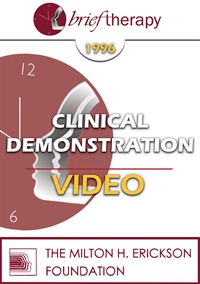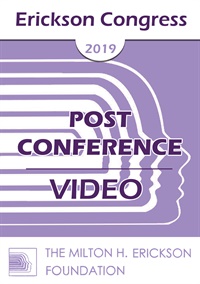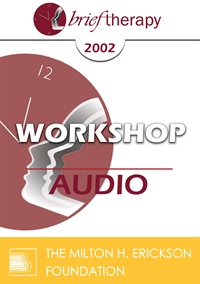
- Average Rating:
- Not yet rated
- Topic Areas:
- Workshops | Brief Therapy | Ericksonian Hypnosis and Therapy Techniques | Psychotherapy | Resources | Self-Relations
- Categories:
- Brief Therapy Conference | Brief Therapy Conference 2002
- Faculty:
- Stephen Gilligan, PhD
- Duration:
- 2:26:58
- Format:
- Audio Only
- Original Program Date:
- Dec 12, 2002
- Short Description:
- A key idea in Milton Erickson's work was that a person's problematic experiences and behaviors can be skillfully accepted and utilized as the basis for therapeutic change. Self-relations psychotherapy develops this idea further, emphasizing symptoms as indicating the death of an old identity and the impending birth of a new identity. In this workshop, we will see how a therapist can generate a ritual space where symptoms and other disturbing experiences can be "midwifed" into new identities.
- Price:
- $15.00 - Base Price
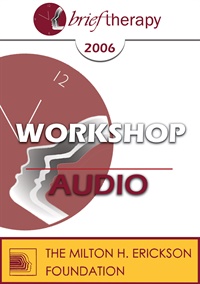
- Average Rating:
- Not yet rated
- Topic Areas:
- Workshops | Brief Therapy | Ericksonian Hypnosis and Therapy Techniques | Resources | Self-Relations | Utilization | Solution Oriented Approach
- Categories:
- Brief Therapy Conference | Brief Therapy Conference 2006
- Faculty:
- Stephen Gilligan, PhD
- Duration:
- 2:37:46
- Format:
- Audio Only
- Original Program Date:
- Dec 09, 2006
- Short Description:
- A key idea in Milton Erickson's work was that a person's problematic experiences and behaviors can be skillfully accepted and utilized as the basis for therapeutic change. Self-relations psychotherapy develops this idea further, emphasizing symptoms as indicating the death of an old identity and the impending birth of a new identity. Thus, we don't try to "get rid of" depression, anxiety, or "acting out/acting in" expressions, but instead invite them into a human relationship of "sponsorship", where their healing and helpful nature may be realized. We will see how a therapist can generate a ritual space where symptoms and other disturbing experiences can be "midwifed" into new identities.
- Price:
- $15.00 - Base Price
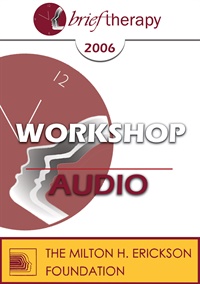
- Average Rating:
- Not yet rated
- Topic Areas:
- Workshops | Self-Relations | Psychotherapy | Brief Therapy
- Categories:
- Brief Therapy Conference | Brief Therapy Conference 2006
- Faculty:
- Stephen Gilligan, PhD
- Duration:
- 2:12:07
- Format:
- Audio Only
- Original Program Date:
- Dec 09, 2006
- Short Description:
- For therapy to have value, it must be able to activate and work with disconnected parts of a person's self-identity. We will examine different ways to access and stay connected to these "neglected selves" during therapeutic work. The clinical concept of the neglected self will first be overviewed, followed by exercises for identifying and transforming a neglected self, followed by a brief therapeutic demonstration.
- Price:
- $15.00 - Base Price
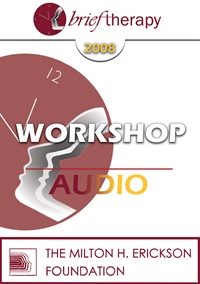
- Average Rating:
- Not yet rated
- Topic Areas:
- Workshops | Brief Therapy | Psychotherapy | Resources | Self-Relations
- Categories:
- Brief Therapy Conference | Brief Therapy Conference 2008
- Faculty:
- Stephen Gilligan, PhD
- Duration:
- 2:43:52
- Format:
- Audio Only
- Original Program Date:
- Dec 14, 2008
- Short Description:
- A key idea in Milton Erickson's work was that a person's problematic experiences and behaviors can be skillfully accepted and utilized as the basis for therapeutic change. Self-relations psychotherapy develops this idea further, emphasizing symptoms as indicating the death of an old identity and the impending birth of a new identity. Thus, we don't try to "get rid of" depression, anxiety, or other "acting out/acting in" expressions, but instead invite them into a human relationship of "sponsorship", where their healing and helpful nature may be realized. In this workshop, we will see how a therapist can generate a ritual space where symptoms and other disturbing experiences can be "midwifed" into new identities.
- Price:
- $15.00 - Base Price
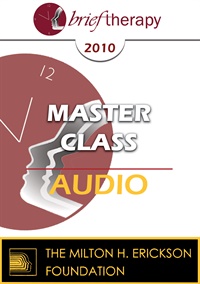
- Average Rating:
- Not yet rated
- Topic Areas:
- Hypnotherapy | Master Classes | Self-Relations | Ericksonian Hypnosis and Therapy Techniques | Psychotherapy
- Categories:
- Brief Therapy Conference | Brief Therapy Conference 2010
- Faculty:
- Jeffrey Zeig, PhD | Stephen Gilligan, PhD
- Duration:
- 2:38:40
- Format:
- Audio Only
- Original Program Date:
- Dec 13, 2010
- Short Description:
- Ericksonian hypnotherapy and the Self-Relations approach are experiential methods of change. In combination they can be synergistic. Psychotherapy is best when clients have a first hand experience of an alive therapeutic process. Such dynamic empowering experiences pave the way for dynamic understandings. Drs. Gilligan and Zeig will engage with each other and the participants to examine commonalities and differences in their work.
- Price:
- $15.00 - Base Price
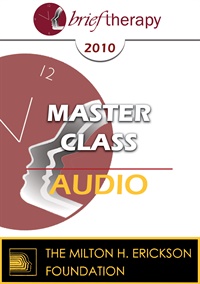
- Average Rating:
- Not yet rated
- Topic Areas:
- Master Classes | Ericksonian Hypnosis and Therapy Techniques | Self-Relations | Hypnotherapy | Psychotherapy
- Categories:
- Brief Therapy Conference | Brief Therapy Conference 2010
- Faculty:
- Stephen Gilligan, PhD | Jeffrey Zeig, PhD
- Duration:
- 2:44:28
- Format:
- Audio Only
- Original Program Date:
- Dec 13, 2010
- Short Description:
- Ericksonian hypnotherapy and the Self-Relations approach are experiential methods of change. In combination they can be synergistic. Psychotherapy is best when clients have a first hand experience of an alive therapeutic process. Such dynamic empowering experiences pave the way for dynamic understandings. Drs. Gilligan and Zeig will engage with each other and the participants to examine commonalities and differences in their work.
- Price:
- $15.00 - Base Price
- Average Rating:
- Not yet rated
- Topic Areas:
- Clinical Demonstrations | Brief Therapy | Self-Relations
- Categories:
- Brief Therapy Conference | Brief Therapy Conference 1993
- Faculty:
- Stephen Gilligan, PhD
- Course Levels:
- Master Degree or Higher in Health-Related Field
- Duration:
- 57:04
- Format:
- Audio and Video
- Original Program Date:
- Dec 11, 1993
- Short Description:
- BT93 Clinical Demonstration 14 - A Self-Relations Approach to Brief Therapy - Stephen Gilligan, PhD
- Price:
-
Sale is $29.00
price reduced from Base Price - $59.00
- Average Rating:
- Not yet rated
- Topic Areas:
- Clinical Demonstrations | Self-Relations | Love
- Categories:
- Brief Therapy Conference | Brief Therapy Conference 1996
- Faculty:
- Stephen Gilligan, PhD
- Course Levels:
- Master Degree or Higher in Health-Related Field
- Duration:
- 53:15
- Format:
- Audio and Video
- Original Program Date:
- Dec 14, 1996
- Short Description:
- BT96 Clinical Demonstration 15 - The Courage to Love: A Self-Relations Demonstration - Stephen Gilligan, PhD
- Price:
-
Sale is $29.00
price reduced from Base Price - $59.00
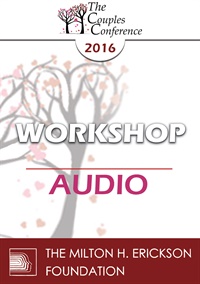
- Average Rating:
- Not yet rated
- Topic Areas:
- Addiction | Workshops | Self-Relations
- Categories:
- Couples Conference | Couples Conference 2016 | Pioneers in Couples and Family Therapy
- Faculty:
- Ellyn Bader, PhD | Sue Diamond, MA, RCC
- Duration:
- 01:55:02
- Format:
- Audio Only
- Original Program Date:
- May 14, 2016
- Short Description:
- Two particularly challenging issues that surface in couples therapy are addiction and self absorption. Through the lens of the Developmental Model of Couples Therapy, Sue and Ellyn will describe how to make strategic treatment decisions that propel couples toward sobriety and more collaborative functioning. They will review the troublesome traits of the self-absorbed partner and illuminate ways to increase other-differentiation and increase caring and compassion.
- Price:
- $15.00 - Base Price
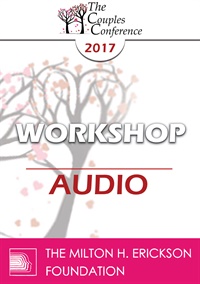
- Average Rating:
- Not yet rated
- Topic Areas:
- Couples Therapy | Workshops | Healing | Self-Relations
- Categories:
- Couples Conference | Couples Conference 2017 | Pioneers in Couples and Family Therapy
- Faculty:
- Janina Fisher, PhD
- Duration:
- 1:38:31
- Format:
- Audio Only
- Original Program Date:
- Apr 02, 2017
- Short Description:
- An exploration of trauma's impact on relationships, this presentation reveals how unresolved childhood experiences fragment our inner selves. Dr. Janina Fisher offers innovative therapeutic techniques to help couples recognize and heal their wounded child parts, transforming conflict into compassionate connection through practical, body-centered approaches.
- Price:
- $15.00 - Base Price
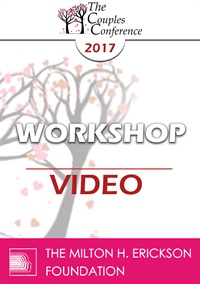
- Average Rating:
- Not yet rated
- Topic Areas:
- Couples Therapy | Workshops | Healing | Self-Relations
- Categories:
- Couples Conference | Couples Conference 2017 | Pioneers in Couples and Family Therapy
- Faculty:
- Janina Fisher, PhD
- Course Levels:
- Master Degree or Higher in Health-Related Field
- Duration:
- 1:38:31
- Format:
- Audio and Video
- Original Program Date:
- Apr 02, 2017
- Short Description:
- An exploration of trauma's impact on relationships, this presentation reveals how unresolved childhood experiences fragment our inner selves. Dr. Janina Fisher offers innovative therapeutic techniques to help couples recognize and heal their wounded child parts, transforming conflict into compassionate connection through practical, body-centered approaches.
- Price:
-
Sale is $29.00
price reduced from Base Price - $59.00
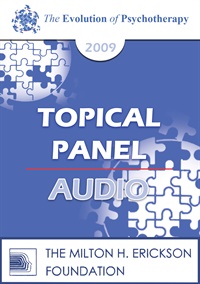
- Average Rating:
- Not yet rated
- Topic Areas:
- Topical Panels | Self-Relations | Solution Oriented Approach | Neuro-Linguistic Programming (NLP) | Psychotherapy | Ericksonian Hypnosis and Therapy Techniques | Milton Erickson
- Categories:
- Evolution of Psychotherapy | Evolution of Psychotherapy 2009 | Pioneers in Couples and Family Therapy
- Faculty:
- Robert Dilts, BA | Stephen Gilligan, PhD | Michele Weiner-Davis, LCSW
- Duration:
- 1 hour
- Format:
- Audio Only
- Original Program Date:
- Dec 12, 2009
- Short Description:
- This panel explores the legacy of Milton Erickson through the lenses of NLP, solution-focused therapy, and self-relations. Robert Dilts highlights Erickson’s process-based approach. Stephen Gilligan focuses on utilization and unconscious dynamics. Michele Weiner-Davis reflects on her shift toward resilience and directive strategies. The conversation also addresses agency challenges and the clinical role of self-disclosure.
- Price:
- $15.00 - Base Price

- Average Rating:
- Not yet rated
- Topic Areas:
- Psychotherapy | Workshops | Generative Psychotherapy | Ericksonian Psychotherapy | Self-Relations | Resources
- Categories:
- Evolution of Psychotherapy | Evolution of Psychotherapy 2013
- Faculty:
- Stephen Gilligan, PhD
- Duration:
- 2 Hours 42 Minutes
- Format:
- Audio Only
- Original Program Date:
- Dec 14, 2013
- Short Description:
- This workshop presents the Ericksonian and Self-Relations Psychotherapy approach to human states of suffering: depression, anxiety, trauma, addiction, etc. This practical and positive approach assumes that each core human experience has equivalent potential to be positive or negative, depending on the human relationship to it; and thus focuses on how problems can be transformed into resources by skillful human connection. This process operates at two levels: (1) developing a generative state (in the therapist, client, and relationship field) and then (2) using specific methods of transforming negative experiences and behaviors.
- Price:
- $15.00 - Base Price
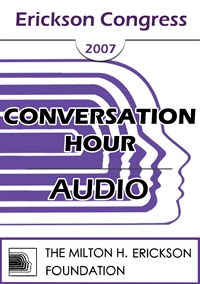
- Average Rating:
- Not yet rated
- Topic Areas:
- Conversation Hours | Self-Relations
- Categories:
- Erickson Congress | Erickson Congress 2007
- Faculty:
- Stephen Gilligan, PhD
- Duration:
- 1:05:54
- Format:
- Audio Only
- Original Program Date:
- Dec 08, 2007
- Short Description:
- IC07 Conversation Hour 03 - Self-Relations Therapy - Stephen Gilligan, PhD
- Price:
- $15.00 - Base Price
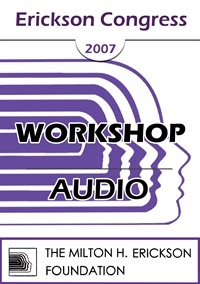
- Average Rating:
- Not yet rated
- Topic Areas:
- Workshops | Anxiety | Depression | Ericksonian Hypnosis and Therapy Techniques | Self-Relations | Utilization
- Categories:
- Erickson Congress | Erickson Congress 2007
- Faculty:
- Stephen Gilligan, PhD
- Duration:
- 1:50:36
- Format:
- Audio Only
- Original Program Date:
- Dec 07, 2007
- Short Description:
- A key idea in Milton Erickson's work was that a person's problematic experiences and behaviors can be skillfully accepted and utilized as the basis for therapeutic change. Self-Relations psychotherapy develops this idea further, emphasizing symptoms as indicating the death of an old identity and the impending birth of a new identity. Thus, we don't try to "get rid of" depression, anxiety, or other "acting out/acting in" expressions, but instead invite them into a human relationship of "sponsorship", where their healing and helpful nature may be realized. We will see how a therapist can generate a ritual space where symptoms and other disturbing experiences can be "midwifed" into new identities.
- Price:
- $15.00 - Base Price
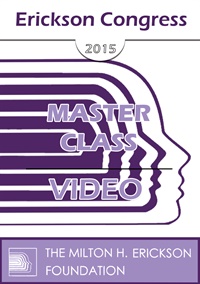
- Average Rating:
- Not yet rated
- Topic Areas:
- Ericksonian Psychotherapy | Psychotherapy | Master Classes | Brief Therapy | Ericksonian Hypnosis and Therapy Techniques | Self-Relations | Experiential Therapy | Hypnosis
- Categories:
- Erickson Congress | Erickson Congress 2015 | Master Class
- Faculty:
- Jeffrey Zeig, PhD | Stephen Gilligan, PhD
- Course Levels:
- Master Degree or Higher in Health-Related Field
- Duration:
- 5 Hours 9 Minutes
- Format:
- Audio and Video
- Original Program Date:
- Dec 13, 2015
- Short Description:
- Ericksonian hypnotherapy and the Self-Relations approach are experiential methods of change. In combination they can be synergistic. Psychotherapy is best when clients have a first-hand experience of an alive therapeutic process. Such dynamic empowering experiences pave the way for dynamic understandings. Drs. Gilligan and Zeig will engage with each other and the participants to examine commonalities and differences in their work.
- Price:
- $99.99 - Base Price
- Average Rating:
- Not yet rated
- Topic Areas:
- Master Classes | Ericksonian Psychotherapy | Psychotherapy | Brief Therapy | Hypnotherapy | Self-Relations | Utilization
- Categories:
- Erickson Congress | Erickson Congress 2019
- Faculty:
- Bill O'Hanlon, MS | Jeffrey Zeig, PhD
- Course Levels:
- Master Degree or Higher in Health-Related Field
- Duration:
- 4 Hours 49 Minutes
- Format:
- Audio and Video
- Original Program Date:
- Dec 16, 2019
- Short Description:
- Ericksonian hypnotherapy and the Self-Relations approach are experiential methods of change. In combination they can be synergistic. Psychotherapy is best when clients have a first-hand experience of an alive therapeutic process. Such dynamic empowering experiences pave the way for dynamic understandings. Bill O’Hanlon and Jeffrey Zeig will engage with each other and the participants to examine commonalities and differences in their work.
- Price:
- $59.00 - Base Price
- Average Rating:
- Not yet rated
- Topic Areas:
- Clinical Demonstrations | Psychology | Self-Relations
- Categories:
- Erickson Congress | Erickson Congress 1994
- Faculty:
- Stephen Gilligan, PhD
- Course Levels:
- Master Degree or Higher in Health-Related Field
- Duration:
- 55:59
- Format:
- Audio and Video
- Original Program Date:
- Dec 10, 1994
- Short Description:
- IC94 Clinical Demonstration 09 - SELF-RELATIONS PSYCHOLOGY - Stephen Gilligan, Ph.D.
- Price:
-
Sale is $29.00
price reduced from Base Price - $59.00



